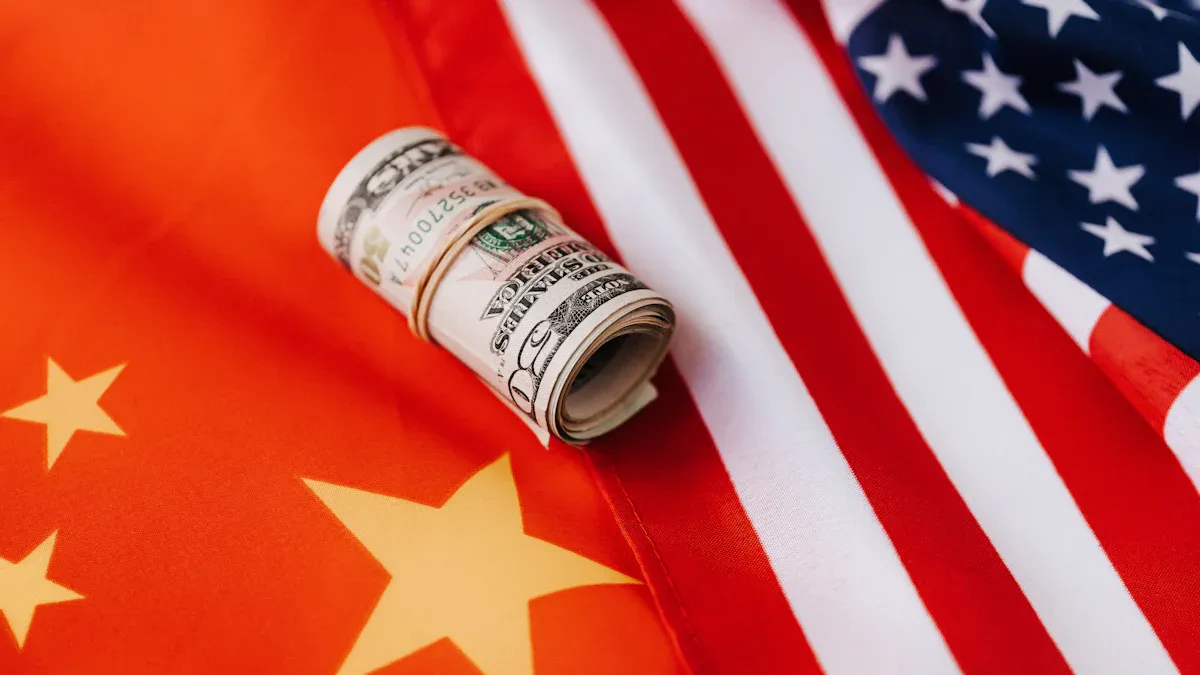US will charge 25% tariffs on foreign-made cars

The United States has announced 25% tariffs on foreign-made cars and auto parts, set to take effect on April 2, 2025. This policy is designed to bolster domestic manufacturing by curbing reliance on imports. The manufacturing trade deficit, which represents 26% of domestic consumption, underscores the necessity of such measures. With global vehicle production reaching 93.9 million units in 2023 and the U.S. importing $210.3 billion worth of passenger vehicles, these 25% tariffs aim to reshape market dynamics. Analysts anticipate significant job growth, with infrastructure investments potentially generating up to 384,600 manufacturing jobs under reduced import scenarios.
Economic Impact of the 25% Tariffs

Price increases for new and used cars
The 25% tariffs are expected to significantly raise the prices of both new and used vehicles. Analysts predict that new car prices could increase by thousands of dollars. For example, Wolfe Research and T.D. Economics estimate price hikes of $3,000 per vehicle, while Anderson Economic Group projects increases of at least $9,000. Popular models like the Ford F-150 may see price jumps of up to $10,000. General tariff impacts suggest an average increase of $5,300 across most vehicles.
Used cars will also face inflationary pressures. Experts like Jeremy Robb anticipate year-over-year price increases ranging from 2.2% to 2.8%. Erin Keating and Charlie Chesbrough agree that tariffs will lead to higher costs across nearly all vehicle categories, with some prices rising by 10% or more. These projections highlight the broad impact of the tariffs on vehicle affordability.
Source | Estimated Price Increase |
|---|---|
Wolfe Research | $3,000 |
T.D. Economics | $3,000 |
Anderson Economic Group | At least $9,000 |
Ford F-150 Impact | Up to $10,000 |
General Tariff Impact | $5,300 |
Used Vehicle Inflation | 2.2% to 2.8% |
Effects on consumer spending and inflation
Higher vehicle prices will likely alter consumer spending patterns and contribute to inflation. Studies from J.P. Morgan show that tariffs act as a tax on imports, with nearly all price increases passed directly to consumers. Historical data from the University of Chicago reveals that tariffs on washing machines led to price hikes of $86 per unit, resulting in $1.5 billion in additional consumer costs.
Consumer sentiment is also expected to decline. The University of Michigan found that fears of tariff-induced price increases caused a 9.8% drop in consumer confidence. Inflation expectations rose from 3.3% to 4.3% during similar tariff implementations. These findings suggest that the 25% tariffs could have a ripple effect on broader economic conditions, influencing household budgets and overall spending behavior.
Source | Findings |
|---|---|
J.P. Morgan | Tariffs lead to higher consumer prices, passed nearly one-for-one. |
University of Chicago | Washing machine tariffs raised prices by $86, adding $1.5 billion in costs. |
University of Michigan | Consumer sentiment fell 9.8%, inflation expectations rose to 4.3%. |
Potential job creation and losses in the automotive sector
The tariffs may create jobs in domestic manufacturing while causing losses in other areas of the automotive sector. Labor market reports indicate that overall job growth could reach 254,000, surpassing earlier projections of 150,000. The private sector is expected to add 223,000 jobs, marking the highest growth since March.
However, the automotive sector may experience mixed outcomes. Manufacturing jobs could increase, but dealership employment has declined since February 2020. Analysts predict 1,300 new jobs in automotive manufacturing but estimate losses of 8,800 positions in related industries. These figures reflect the complex impact of the tariffs on employment, with gains in production offset by challenges in retail and distribution.
Sector | Job Creation | Job Losses | Notes |
|---|---|---|---|
Overall Job Growth | 254,000 | N/A | Outpaced anticipated growth of 150,000 |
Private Sector | 223,000 | N/A | Highest growth since March |
Automotive Sector | 1,300 | 8,800 | Dealership employment down since Feb 2020 |
Industry Reactions to the 25% Tariffs
Automakers’ investments in U.S. production
Automakers have responded to the 25% tariffs by ramping up investments in U.S.-based production facilities. Companies like Hyundai, Tesla, and General Motors have announced significant financial commitments to expand their domestic operations. Hyundai plans to invest $21 billion in the U.S., including a $5.8 billion steel plant in Louisiana. Tesla has also committed nearly $200 million to build a new manufacturing plant near Houston. These investments aim to reduce reliance on imported vehicles and parts while aligning with the new tariff regulations.
The table below highlights the scale of automakers’ investments in the U.S.:
Automaker | Overview | Financials | Product Portfolio | Business Strategy | Recent Developments |
|---|---|---|---|---|---|
General Motors | Yes | Yes | Yes | Yes | Yes |
Ford Motor Company | Yes | Yes | Yes | Yes | Yes |
Tesla Inc. | Yes | Yes | Yes | Yes | Yes |
Toyota Motor Corporation | Yes | Yes | Yes | Yes | Yes |
Hyundai Motor America | Yes | Yes | Yes | Yes | Yes |
These developments reflect a strategic shift among automakers to strengthen their U.S. presence and mitigate the impact of the tariffs.
Supply chain adjustments and production strategies
The 25% tariffs have prompted automakers to reevaluate their supply chains and production strategies. Many companies are diversifying their sourcing to balance cost and resilience. For example, 78% of manufacturers are now investing in supply chain planning software to enhance efficiency. This trend indicates a growing reliance on digital tools to manage complex supply chains.
Future trends in the industry include the adoption of big data, supply chain digitization, and advanced analytics. These innovations are expected to transform supply chain management by 2027, enabling automakers to adapt to the evolving regulatory environment. Companies are also forming stronger partnerships with local suppliers to reduce dependency on foreign imports.
Evidence Type | Description |
|---|---|
Strategy Shift | Companies are diversifying sources and enhancing partnerships. |
Technology Investment | 78% of manufacturers are adopting supply chain planning software. |
Future Trends | Big data and advanced analytics will reshape supply chains by 2027. |
Stock market and investor responses
The stock market has shown heightened sensitivity to the announcement of the 25% tariffs. Investor sentiment fluctuated significantly, with reports indicating that stocks surged when there were signs of reduced tariff scope. However, the S&P 500 experienced a 5% decline on days when the U.S. announced tariffs in 2018 and 2019. Retaliatory tariffs from other countries caused an even sharper drop of 7%.
Impact Description | Estimated Change |
|---|---|
U.S. economic growth | Decrease by 0.5% – 1% |
Inflation outlook | Increase by 0.5% – 1% |
Stock market volatility | Elevated levels expected |
S&P 500 fair value | Decline by 5% in near term |
These trends highlight the direct correlation between tariff policies and market reactions. Investors remain cautious as they assess the long-term implications of the tariffs on the automotive industry and the broader economy.
International Reactions and Trade Relations

Retaliatory measures from affected countries
Countries impacted by the 25% tariffs have announced retaliatory measures targeting U.S. exports. These actions aim to counterbalance the economic effects of the tariffs and protect their domestic industries. For instance, China plans to impose tariffs on $13.9 billion worth of U.S. exports at rates of 10% and 15%, with additional measures targeting agricultural products. Canada has outlined a series of retaliatory tariffs, including a 25% duty on $20.8 billion of U.S. exports, with further rounds scheduled. The European Union has also responded, targeting $28 billion worth of U.S. goods with phased tariffs.
Country | Retaliatory Measures | Effective Date |
|---|---|---|
China | Tariffs on $13.9 billion of U.S. exports (10%-15%) and additional agricultural tariffs. | February 10, March 10 |
Canada | 25% tariffs on $20.8 billion of U.S. exports, with further rounds planned. | March 4, March 13, March 23 |
European Union | Tariffs on $28 billion of U.S. exports, implemented in two phases. | April 1, April 13 |
These measures highlight the global ripple effect of the U.S. tariff policy, with affected nations taking steps to safeguard their economic interests.
Impact on US trade relations with Mexico, Canada, and others
The 25% tariffs have strained U.S. trade relations with key partners, including Mexico and Canada. Both countries, as part of the United States-Mexico-Canada Agreement (USMCA), play a vital role in the North American automotive supply chain. Mexico, which exports 76% of its vehicles to the U.S., faces significant challenges due to the tariffs. Similarly, Canada, with 93% of its vehicle exports destined for the U.S., has expressed concerns about the policy's impact on trade balance and economic stability.
Other nations, such as Japan and Germany, have also voiced opposition, citing potential disruptions to global trade. Organizations like the Census Bureau and the International Trade Commission (ITC) provide detailed analyses of these impacts, while the Office of the United States Trade Representative (USTR) continues to monitor trade barriers and agreements.
USMCA, Canada, & Mexico Readings: Comprehensive insights into trade relations.
Statistics Canada & INEGI: Data on trade flows and economic impacts.
World Bank & IMF: Reports on trade agreements and their broader implications.
These strained relations underscore the need for diplomatic efforts to address the challenges posed by the tariffs.
Role of international trade organizations
International trade organizations play a crucial role in mitigating disputes arising from policies like the 25% tariffs. The World Trade Organization (WTO), for example, provides a structured dispute resolution mechanism that emphasizes negotiations and legal examination. This ensures fairness and compliance with global trade laws.
Key Features | Description |
|---|---|
Dispute Resolution Mechanism | Maintains global trade harmony through structured processes. |
Emphasis on Negotiations | Encourages direct discussions to resolve disputes amicably. |
Legal Examination | Ensures fairness through formal panel reviews. |
Compliance Importance | Upholds the rule of law in international trade. |
Successful Case Example | Brazil-U.S. cotton conflict resolved through WTO mechanisms. |
Case studies, such as the Brazil-U.S. cotton dispute and the EU-Latin America banana trade conflict, demonstrate the WTO's effectiveness in resolving complex issues. These examples highlight the organization's ability to foster cooperation and stability in global trade.
Short-Term vs Long-Term Implications of the 25% Tariffs
Immediate effects on car prices and consumer choices
The introduction of the 25% tariffs will immediately impact car prices, making vehicles more expensive for consumers. Analysts from Wolfe Research and T.D. Economics predict an average price increase of $3,000 per vehicle. Larger vehicles, such as full-size SUVs with significant Mexican content, could see price hikes of $9,000 to $10,000, according to the Anderson Economic Group.
Source | Findings |
|---|---|
Wolfe Research | Price increase of $3,000 for the average car |
T.D. Economics | Price increase of $3,000 for the average car |
Anderson Economic Group | Price increase of $9,000 to $10,000 for SUVs |
These price changes will likely alter consumer behavior. Buyers may delay purchases or opt for smaller, more affordable models. The used car market could also experience increased demand, driving up prices further. This shift in consumer choices highlights the immediate economic ripple effects of the tariffs.
Long-term prospects for domestic manufacturing and innovation
In the long term, the 25% tariffs aim to strengthen domestic manufacturing and foster innovation. Economic projections suggest that real GDP growth will reach 2.6% in 2025, with consumer spending growing by 2.9%. By 2026, GDP growth is expected to stabilize at 2.1%, reflecting the gradual adaptation of the economy to the new trade environment.
Year | Real GDP Growth | Real Exports Growth | Real Imports Growth | Consumer Spending Growth |
|---|---|---|---|---|
2025 | 2.6% | 0.7% | 1.8% | 2.9% |
2026 | 2.1% | 1.0% | 0.9% | 1.4% |
The policy could also encourage automakers to invest in productivity-enhancing technologies. Tax incentives for domestic producers may further stimulate growth. These measures aim to create a competitive edge for U.S. manufacturers, driving innovation and reducing reliance on imports.
Potential benefits include:
Increased investment in advanced manufacturing technologies.
Tax cuts designed to support domestic production.
Risks of trade wars and global economic instability
The 25% tariffs carry significant risks, including the potential for trade wars and economic instability. A universal 10% rise in U.S. tariffs could reduce U.S. GDP by 1% and global GDP by 0.5% through 2026. J.P. Morgan Research has raised the probability of a global recession to 40%, up from 30%, due to escalating trade tensions.
Evidence Type | Description |
|---|---|
Economic Impact | A universal 10% rise in tariffs could reduce U.S. GDP by 1% and global GDP by 0.5%. |
Recession Risk | J.P. Morgan Research indicates a 40% risk of a global recession. |
Sentiment Shock | Rising trade policy uncertainty contributes to negative economic sentiment. |
Uncertainty surrounding trade policies can also harm investor confidence and disrupt global supply chains. These risks underscore the importance of carefully managing trade relations to avoid long-term economic harm.
The 25% tariffs on foreign-made cars mark a transformative shift in U.S. trade policy. This strategy aims to boost domestic manufacturing but may lead to higher consumer costs and strained international relations. Retrospective studies on trade policies reveal significant economic impacts, such as the $30 billion tax increase from a proposed tariff hike on Chinese imports.
Balancing economic growth with stable trade relations remains critical. A study on the U.S.–China trade deficit from 2001 to 2015 highlights the importance of rebalancing trade to foster growth while maintaining global stability.
Key insights include:
Trade deficits can harm domestic job markets.
Strategic policies are essential for sustainable economic growth.
The long-term success of this policy depends on achieving this delicate balance.
See Also
Transforming Data Into Insightful Decisions For Automotive Demand
Maximizing Efficiency Within Your Automotive Supply Chain
Achieving Success in International Trade Through JUSDA
Expert Strategies for Overcoming Automotive Supply Chain Challenges
